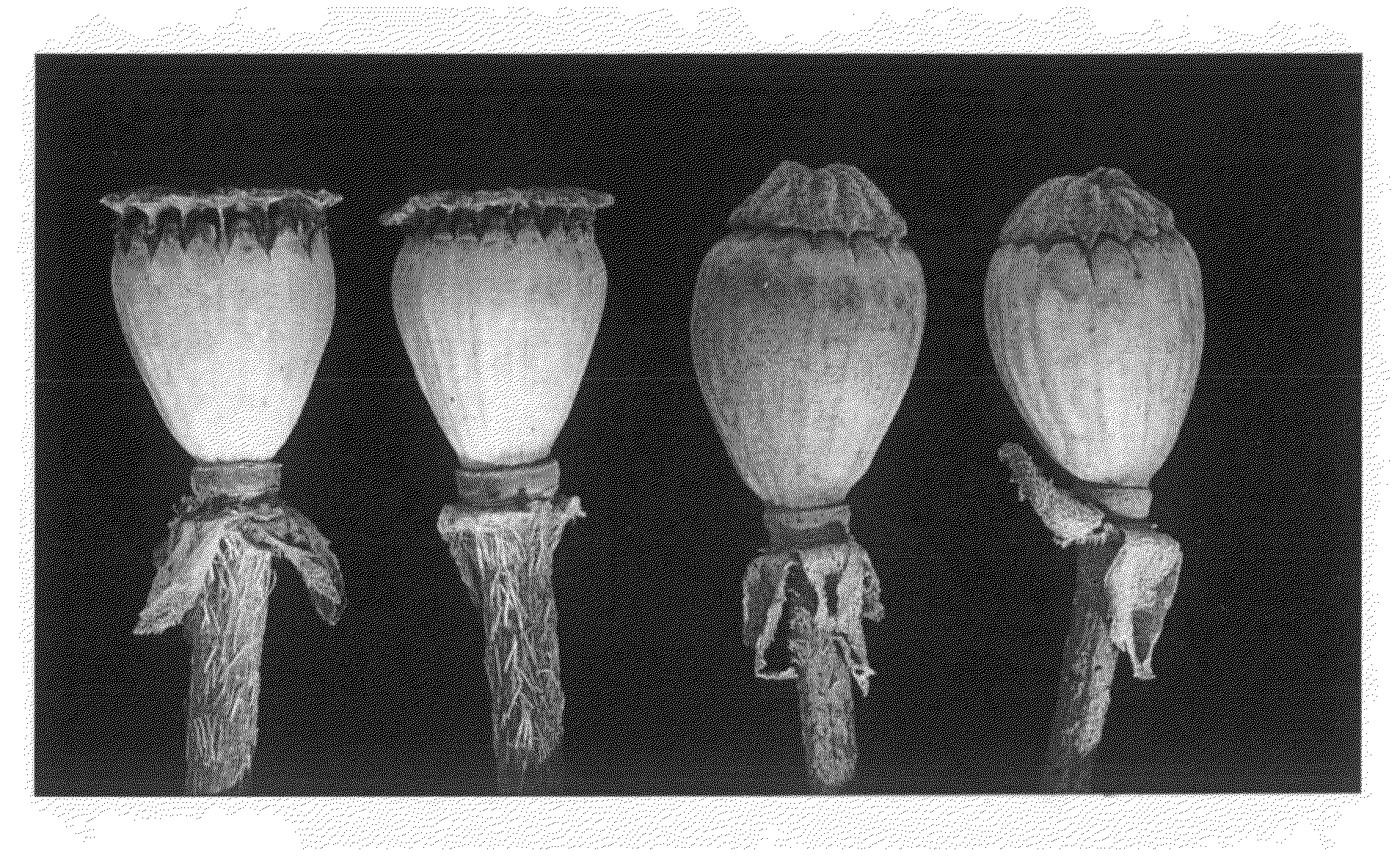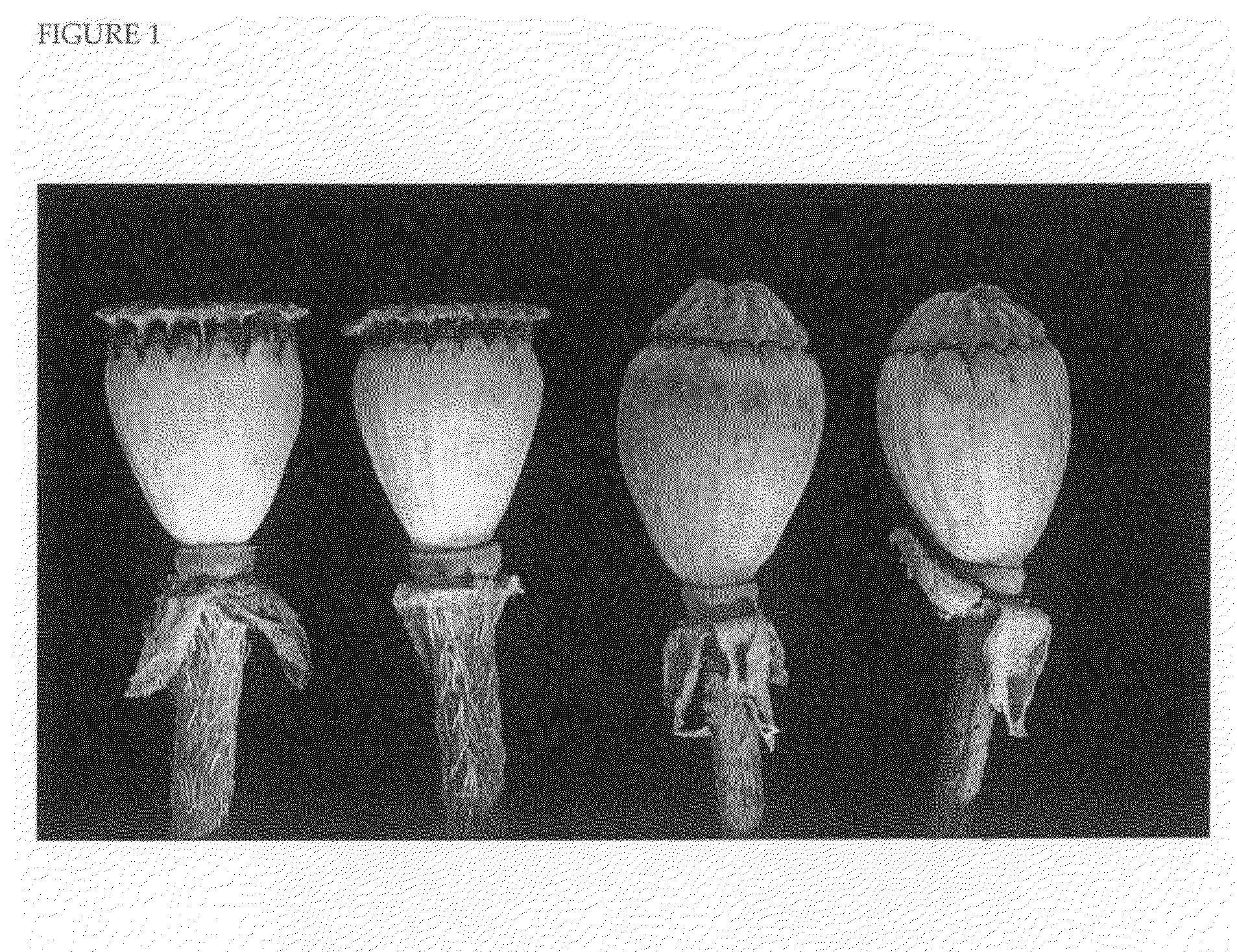Cultivars of the poppy papaver bracteatum that produce seed capsules and thebaine in the first growing season
a papaver bracteatum and cultivar technology, applied in the field of papaver cultivars, can solve the problems of not producing seed and commercially viable thebaine poppies cannot be harvested, and achieve the effects of reducing the amount of seed
- Summary
- Abstract
- Description
- Claims
- Application Information
AI Technical Summary
Benefits of technology
Problems solved by technology
Method used
Image
Examples
example 1
Morphological Description of Papaver bracteatum PB-1 and Papaver bracteatum PB-2
[0090]Presented below are selected morphological characteristics of two bred poppy cultivars, Papaver bracteatum PB-1 and Papaver bracteatum PB-2.
[0091]Each of the cultivars has substantially identical morphological characteristics other than that cultivar PB-1 comprises an indehiscent seed capsule, while cultivar PB-2 comprises a dehiscent seed capsule. A summary of the morphological characteristics of the cultivars is shown below:
Plant height at full maturity:1.2 to 1.5 metersPeduncle length: 50-80 cm,Peduncle colourgreen, light brown later prior to harvest.Number of capsules:1-17 capsules per plant.Capsule dehiscence at PB-1-indehiscentmaturity:PB-2-dehiscentCapsule size:1.4-4.7 g% total weight seed:39-54%LOD: 9-12%Anhydrous Assay: 2-5%Mass of one seed:0.00023 gSeeds per capsule:9,000-12,000Days to flowering:approx 160 days.Days to harvest:approx 330 days.
[0092]A photograph showing the differences in...
example 2
Thebaine Production in Papaver bracteatum PB-1 and Papaver bracteatum PB-2
[0095]Seeds of Papaver bracteatum PB-1 and Papaver bracteatum PB-2 were planted in March in Tasmania Australia. The plants were allowed to grow and produce seed capsules. Seed capsules were harvested the following February (ie. at the end of the first growing season).
[0096]The seed capsules were dried to a moisture level of 9-16% as determined by a Loss On Drying (LOD) analysis.
[0097]Sample of the dried seed capsules from each of the Papaver bracteatum cultivars were finely ground using the laboratory mill. A 3.0 g sample was extracted in 100 mL of 10% acetic acid, stirring for 20 minutes. The sample was analysed using gradient elution HPLC using UV detection at 284 nm, referenced to a certified thebaine standard.
[0098]The assays of first year poppy heads from the two Papaver bracteatum cultivars, PB-1 and PB-2 varied from 1.86% to 3.88% anhydrous thebaine by weight of the dried seed capsules.
PUM
| Property | Measurement | Unit |
|---|---|---|
| area | aaaaa | aaaaa |
| height | aaaaa | aaaaa |
| width | aaaaa | aaaaa |
Abstract
Description
Claims
Application Information
 Login to View More
Login to View More - R&D
- Intellectual Property
- Life Sciences
- Materials
- Tech Scout
- Unparalleled Data Quality
- Higher Quality Content
- 60% Fewer Hallucinations
Browse by: Latest US Patents, China's latest patents, Technical Efficacy Thesaurus, Application Domain, Technology Topic, Popular Technical Reports.
© 2025 PatSnap. All rights reserved.Legal|Privacy policy|Modern Slavery Act Transparency Statement|Sitemap|About US| Contact US: help@patsnap.com



